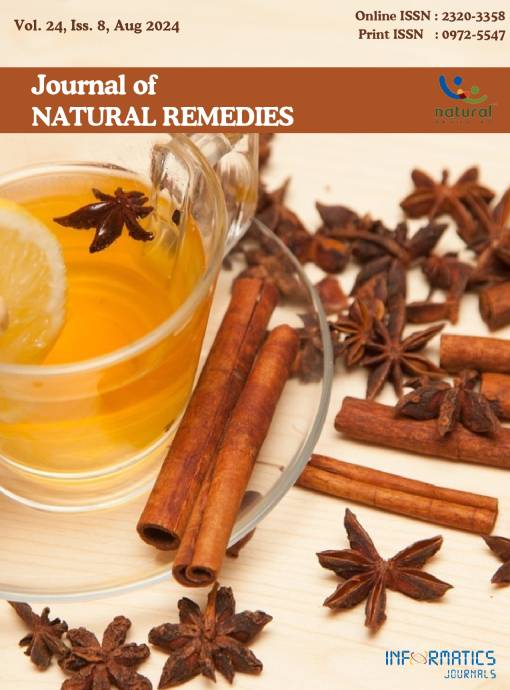Reversed Phase - HPLC Method Development and Validation for Simultaneous Estimation of Berberine Hydrochloride, Plumbagin, Conessine in Ayurvedic Formulation
DOI:
https://doi.org/10.18311/jnr/2024/42011Keywords:
Ayurvedic Formulation, Berberine, Conessine, Plumbagin, ValidationAbstract
Background: The objective of this research was to create a dependable RP-HPLC analytical technique for concurrently determining the levels of conessine, berberine HCl, and plumbagin in an ayurvedic formulation. Aim: The main goals were to develop a straightforward, precise, and consistent method for the pharmaceutical analysis of these compounds. Methods: The analytical method was developed using a BDS hypersil C18 tertiary mode column with a mobile phase incorporating 1% perchloric acid in water: methanol: acetonitrile (10:40:65% v/v/v). The analysis utilized a 1 ml/min flow rate, and detection was performed at 212 nm utilizing a PDA detector, SPD-20 A. The retention times for conessine, berberine HCl, and plumbagin were determined to be 3.12 minutes, 6.60 minutes, and 13.64 minutes, respectively. Linearity assessments were conducted in the concentration range of 25–75 ppm for all three phytomarkers. The correlation coefficients for conessine, berberine HCl, and plumbagin were found to be 0.999, 0.999, and 0.997, respectively. Results: The developed RP-HPLC method exhibited excellent linearity for all three compounds. Limit of detection and limit of quantification values were determined, with conessine at 1.36 μg/ml and 1.78 μg/ml, berberine HCl at 3.52 μg/ml and 4.12 μg/ml, and plumbagin at 5.40 μg/ml and 10.67 μg/ml, respectively. Precision studies, including inter-day and intra-day, demonstrated RSD values less than 2.00%. Accuracy was assessed through standard recovery methods, revealing satisfactory recovery values for conessine (100.0%–99.8%), berberine HCl (101.0%–100.9%), and plumbagin (101.4%–99.4%). Conclusion: The developed RP-HPLC method offers a robust and precise tool for the simultaneous estimation of conessine, berberine HCl, and plumbagin in ayurvedic formulations. The method’s accuracy and reproducibility make it suitable for use as a standardization tool in the evaluation of formulations containing these marker compounds. This study contributes to the analytical methods available for quality control in the pharmaceutical industry, particularly in the context of ayurvedic formulations.
Downloads
Metrics
Published
How to Cite
Issue
Section
License
Copyright (c) 2024 Bhushan Sonawane, Disha Prajapati, Tanvi Dodiya, Janvi Patel, Kehavnam Chitte (Author)

This work is licensed under a Creative Commons Attribution 4.0 International License.
Accepted 2024-07-10
Published 2024-08-31
References
Skoog DA, Holler FJ, Crouch SR. Textbook “Principles of instrumental analysis”. Cengage Learn core ac uk https// core ac uk/download/pdf/232277508pdf. 2019.
Silverstein RM, Bassler GC. Spectrometric identification of organic compounds. J Chem Educ. 1962; 39(11):546. https://doi.org/10.1021/ed039p546
(India) C of Sand IR. The wealth of India: a dictionary of Indian raw materials and industrial products. Vol. 9. Council of Scientific and Industrial Research; 1972.
Abraham G. A review on hepato-protective herbs used in ayurveda. Glob J Res Med Plants Indig Med. 2014; 3(7):303.
Joshi H, Kanaki N. Quantitative analysis of berberine in an ayurvedic formulation-Rasayana churna by UV spectrophotometry. J Pharm Sci Biosci Res. 2013; 3(1):32-4.
Meena AK, Rekha P, Perumal A, Ilavarasan R, Singh R, Srikant N, et al. Identification and estimation of bioactive constituents negundoside, berberine chloride, and marmelosin by HPLC and HPTLC for development of quality control protocols for ayurvedic medicated oil formulation. Futur J Pharm Sci. 2021; 7:1-9. https://doi.org/10.1186/s43094-021-00322-3 PMid:34466412 PMCid:PMC8390083
Jain V, Tandel L, Sonone R. Novel isocratic RP-HPLC method for simultaneous estimation of berberine and aloe-emodin. Res J Pharm Technol. 2021; 14(2):657-61. https://doi.org/10.5958/0974-360X.2021.00117.7
Kaewbumrung S, Panichayupakaranant P. Isolation of three antibacterial naphthoquinones from plumbago indica roots and development of a validated quantitative HPLC analytical method. Nat Prod Res. 2012; 26(21):2020-3. https://doi.org/ 10.1080/14786419.2011.628670 PMid:22010802
Rajasekaran A, Kumar N. Rasont - A traditional crude drug prepared from Berberis sp and its uses. 2009.
KR PS, Yoganarasimhan SN. Evaluation of antibacterial activity of Elanir kujambu - An Ayurvedic eye formulation. 2009.
Rina R, Baile M, Jain AA. Review: analytical method development and validation. Syst Rev Pharm. 2021; 12(11):3601-5.
Ray R, Gururaja KV, Ramchandra TV. Predictive distribution modeling for rare Himalayan medicinal plant Berberis aristata DC. J Environ Biol. 2011; 32(6):725.
Srivastava SK, Khatoon S, Rawat AKS, Mehrotra S, Pushpangadan P. Pharmacognostic Evaluation of the Root of Berberis aristata DC. Nat Prod Sci. 2001; 7(4):102-6.
Singh M, Sharma E. Preliminary phytochemical investigation of Berberis aristata, Acacia catechu and Ficus benghalensis - important medicinal plants for photoprotection. Int J Biol Pharma Res. 2013; 4:614-7.
Shahid M, Rahim T, Shahzad A, Latif TA, Fatma T, Rashid M, et al. Ethnobotanical studies on Berberis aristata DC. root extracts. African J Biotechnol. 2009; 8(4).

 Bhushan Sonawane
Bhushan Sonawane









 0.35
0.35 24
24 0.161
0.161